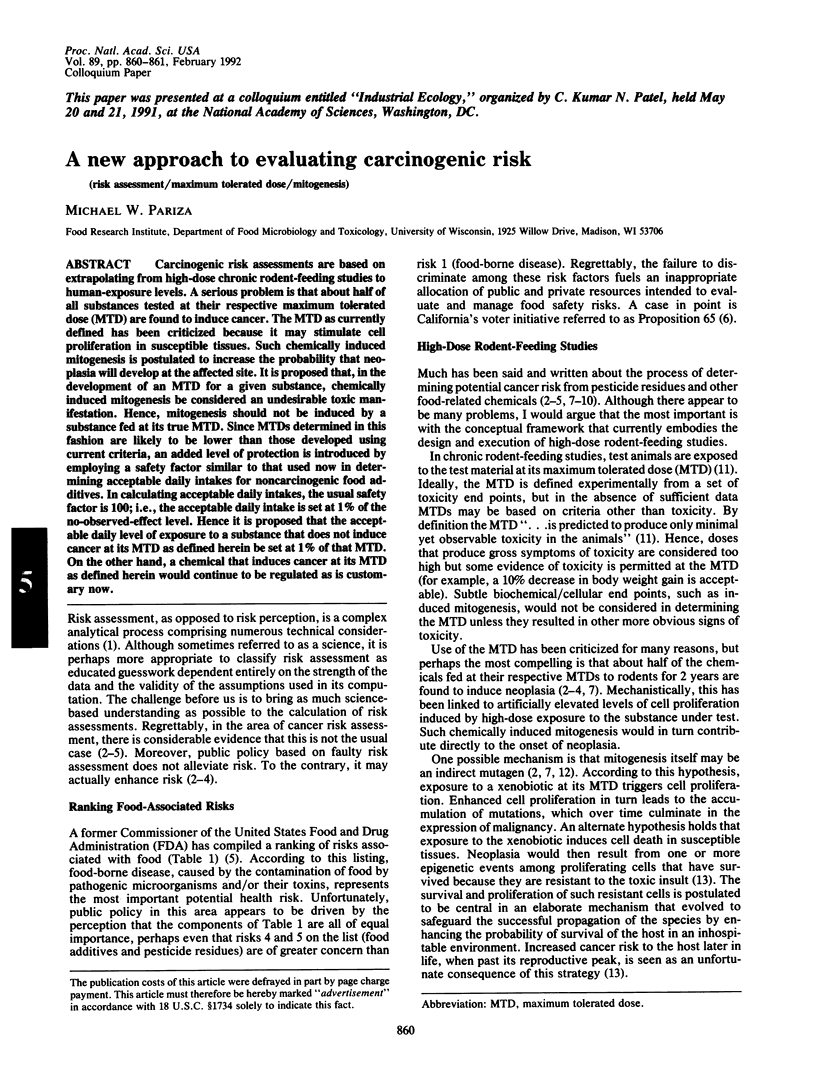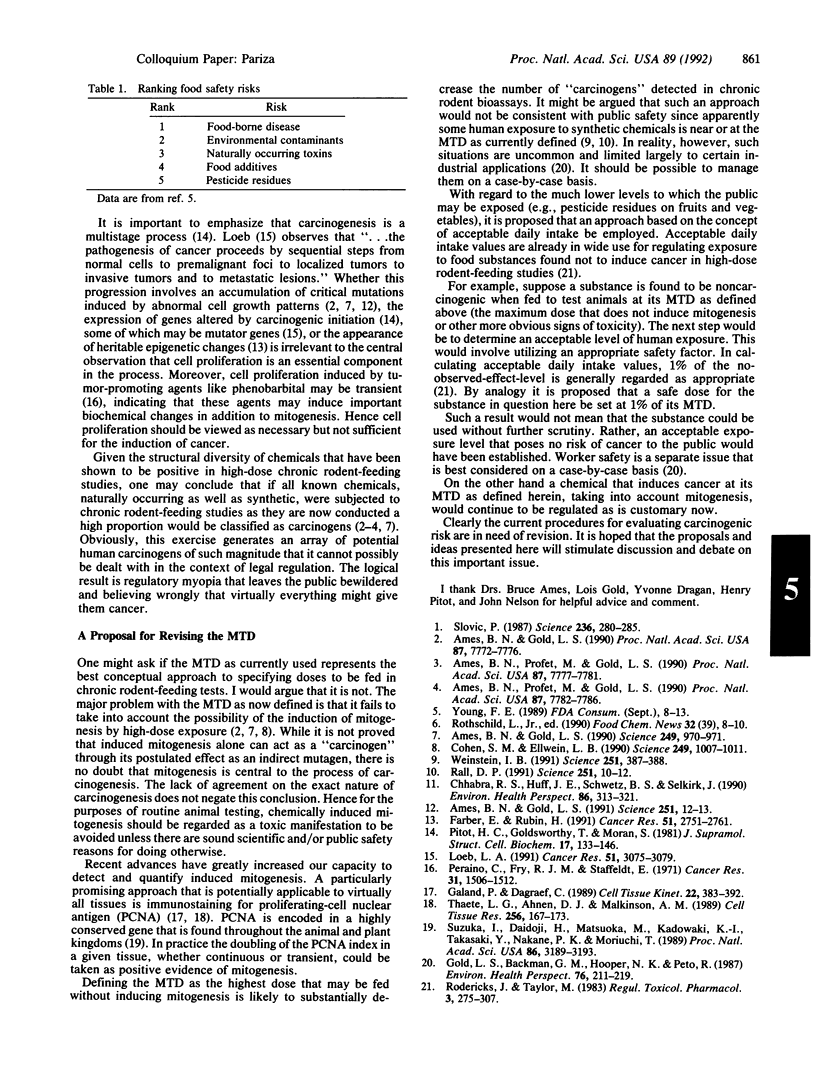Abstract
Carcinogenic risk assessments are based on extrapolating from high-dose chronic rodent-feeding studies to human-exposure levels. A serious problem is that about half of all substances tested at their respective maximum tolerated dose (MTD) are found to induce cancer. The MTD as currently defined has been criticized because it may stimulate cell proliferation in susceptible tissues. Such chemically induced mitogenesis is postulated to increase the probability that neoplasia will develop at the affected site. It is proposed that, in the development of an MTD for a given substance, chemically induced mitogenesis be considered an undesirable toxic manifestation. Hence, mitogenesis should not be induced by a substance fed at its true MTD. Since MTDs determined in this fashion are likely to be lower than those developed using current criteria, an added level of protection is introduced by employing a safety factor similar to that used now in determining acceptable daily intakes for noncarcinogenic food additives. In calculating acceptable daily intakes, the usual safety factor is 100; i.e., the acceptable daily intake is set at 1% of the no-observed-effect level. Hence it is proposed that the acceptable daily level of exposure to a substance that does not induce cancer at its MTD as defined herein be set at 1% of that MTD. On the other hand, a chemical that induces cancer at its MTD as defined herein would continue to be regulated as is customary now.
Full text
PDF

Selected References
These references are in PubMed. This may not be the complete list of references from this article.
- Ames B. N., Gold L. S. Chemical carcinogenesis: too many rodent carcinogens. Proc Natl Acad Sci U S A. 1990 Oct;87(19):7772–7776. doi: 10.1073/pnas.87.19.7772. [DOI] [PMC free article] [PubMed] [Google Scholar]
- Ames B. N., Gold L. S. Response. Science. 1991 Jan 4;251(4989):12–13. doi: 10.1126/science.251.4989.12. [DOI] [PubMed] [Google Scholar]
- Ames B. N., Gold L. S. Too many rodent carcinogens: mitogenesis increases mutagenesis. Science. 1990 Aug 31;249(4972):970–971. doi: 10.1126/science.2136249. [DOI] [PubMed] [Google Scholar]
- Ames B. N., Profet M., Gold L. S. Dietary pesticides (99.99% all natural). Proc Natl Acad Sci U S A. 1990 Oct;87(19):7777–7781. doi: 10.1073/pnas.87.19.7777. [DOI] [PMC free article] [PubMed] [Google Scholar]
- Ames B. N., Profet M., Gold L. S. Nature's chemicals and synthetic chemicals: comparative toxicology. Proc Natl Acad Sci U S A. 1990 Oct;87(19):7782–7786. doi: 10.1073/pnas.87.19.7782. [DOI] [PMC free article] [PubMed] [Google Scholar]
- Chhabra R. S., Huff J. E., Schwetz B. S., Selkirk J. An overview of prechronic and chronic toxicity/carcinogenicity experimental study designs and criteria used by the National Toxicology Program. Environ Health Perspect. 1990 Jun;86:313–321. doi: 10.1289/ehp.9086313. [DOI] [PMC free article] [PubMed] [Google Scholar]
- Cohen S. M., Ellwein L. B. Cell proliferation in carcinogenesis. Science. 1990 Aug 31;249(4972):1007–1011. doi: 10.1126/science.2204108. [DOI] [PubMed] [Google Scholar]
- Farber E., Rubin H. Cellular adaptation in the origin and development of cancer. Cancer Res. 1991 Jun 1;51(11):2751–2761. [PubMed] [Google Scholar]
- Galand P., Degraef C. Cyclin/PCNA immunostaining as an alternative to tritiated thymidine pulse labelling for marking S phase cells in paraffin sections from animal and human tissues. Cell Tissue Kinet. 1989 Sep;22(5):383–392. doi: 10.1111/j.1365-2184.1989.tb00223.x. [DOI] [PubMed] [Google Scholar]
- Gold L. S., Backman G. M., Hooper N. K., Peto R. Ranking the potential carcinogenic hazards to workers from exposures to chemicals that are tumorigenic in rodents. Environ Health Perspect. 1987 Dec;76:211–219. doi: 10.1289/ehp.8776211. [DOI] [PMC free article] [PubMed] [Google Scholar]
- Loeb L. A. Mutator phenotype may be required for multistage carcinogenesis. Cancer Res. 1991 Jun 15;51(12):3075–3079. [PubMed] [Google Scholar]
- Peraino C., Fry R. J., Staffeldt E. Reduction and enhancement by phenobarbital of hepatocarcinogenesis induced in the rat by 2-acetylaminofluorene. Cancer Res. 1971 Oct;31(10):1506–1512. [PubMed] [Google Scholar]
- Pitot H. C., Goldsworthy T., Moran S. The natural history of carcinogenesis: implications of experimental carcinogenesis in the genesis of human cancer. J Supramol Struct Cell Biochem. 1981;17(2):133–146. doi: 10.1002/jsscb.380170204. [DOI] [PubMed] [Google Scholar]
- Rall D. P. Carcinogens and human health: Part 2. Science. 1991 Jan 4;251(4989):10–13. doi: 10.1126/science.1986406. [DOI] [PubMed] [Google Scholar]
- Rodricks J., Taylor M. R. Application of risk assessment to food safety decision making. Regul Toxicol Pharmacol. 1983 Sep;3(3):275–307. doi: 10.1016/0273-2300(83)90033-8. [DOI] [PubMed] [Google Scholar]
- Slovic P. Perception of risk. Science. 1987 Apr 17;236(4799):280–285. doi: 10.1126/science.3563507. [DOI] [PubMed] [Google Scholar]
- Suzuka I., Daidoji H., Matsuoka M., Kadowaki K., Takasaki Y., Nakane P. K., Moriuchi T. Gene for proliferating-cell nuclear antigen (DNA polymerase delta auxiliary protein) is present in both mammalian and higher plant genomes. Proc Natl Acad Sci U S A. 1989 May;86(9):3189–3193. doi: 10.1073/pnas.86.9.3189. [DOI] [PMC free article] [PubMed] [Google Scholar]
- Thaete L. G., Ahnen D. J., Malkinson A. M. Proliferating cell nuclear antigen (PCNA/cyclin) immunocytochemistry as a labeling index in mouse lung tissues. Cell Tissue Res. 1989 Apr;256(1):167–173. doi: 10.1007/BF00224731. [DOI] [PubMed] [Google Scholar]
- Weinstein I. B. Mitogenesis is only one factor in carcinogenesis. Science. 1991 Jan 25;251(4992):387–388. doi: 10.1126/science.1989073. [DOI] [PubMed] [Google Scholar]


